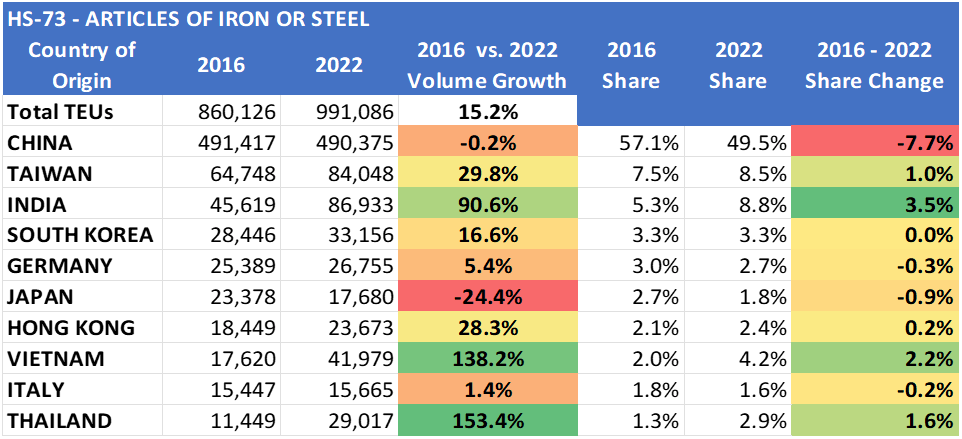The Global Shipping Report
China – U.S. Trade Shift: Where Did the Market Share Go or Did It?
U.S. imports from China have been the subject of media attention since the previous U.S. administration announced tariffs in 2017 and have heightened as tensions between the two countries increased and the pandemic progressed. Many companies have announced plans to find additional or alternate sources to China, but it remains the dominant non-North American trading partner with the U.S. So where are U.S. importers finding alternate sources for their goods and how far have efforts progressed? To help importers understand the shifting trade landscape, Descartes analyzed the top 10 two-digit commodity categories (HS-2 digits) and their top 10 countries of origin (CoO) to see whether China is losing market share and, if so, what countries are displacing it as a top U.S. trading partner.
A twenty-year view of U.S. container imports shows China’s share peaked in 2010 at 44.5% and, when including Hong Kong, that number rose to 50.1% (see Figure 1). China’s share was relatively stable from 2011 to 2017 and then peaked again in 2018. The 2018 peak, however, was heavily influenced by the previous U.S. administration’s imposition of duties on select goods, which caused importers to accelerate shipments into the country to avoid paying the incremental import fees. Since 2019 through to the first five months of 2023, China’s share has declined to 35.8%. Hong Kong also saw a decrease in container imports over the last 20 years with its share peaking at 11.7% in 2004 and declining to 2.3% in the first five months of 2023.
Figure 1: China’s Share of U.S. Container Imports

Source: Descartes Datamyne™
Top 10 Commodity Categories and Country of Origin Analysis
For the seven-year period from 2016 to 2022, Descartes analyzed the top 10 container import goods categories (known as 2-digit HS codes) as of 2016 from largest to smallest (for easy-to-understand HS code examples go to Appendix A) and the related top 10 CoOs for each category to see how trade has shifted and the impact on TEU import share. From a historical perspective, China (Mainland) is measured separately from Hong Kong in this analysis. Key findings include the following:
- Over this period for the top 10 goods categories, China had:
- Two that grew and increased share,
- Five that grew but lost share,
- Two that declined in growth and share, and
- One that declined and dropped out of the top 10 CoO.
- Despite the rise of other countries, China remained the dominant CoO in eight of the top 10 goods categories.
- Across the top 10 goods categories, South and Southeast Asian countries (i.e., India, Bangladesh, Vietnam, Thailand and Indonesia) grew significantly faster than the overall market and China and took import share from China.
- With few exceptions, more industrially mature markets (e.g., Europe, South Korea and Japan) did not benefit from any shifts in trade.
Goods category HS-94 (Furniture, Bedding, etc.) grew 42.8% overall in TEU import volume between 2016 and 2022 (see Figure 2). Imports from China only grew 5% and its share decreased 17.3% to 47.6% in the same period. Vietnam gained the most incremental volume, growing 186.3% with its share increasing 12.4% to 24.7%. In 2016, imports from Vietnam were one-fifth of China’s volume and, by 2022, this had changed to one-half. Other South and Southeast Asian countries such as India, Indonesia and Malaysia also grew considerably, but from a smaller base. Thailand and Cambodia displaced Poland and Macau from the top 10 list. The accelerated growth in South and Southeast Asian countries started in 2018 and continued through 2021.
Figure 2: Top 10 CoO Analysis for HS-94

Source: Descartes Datamyne™
Goods category HS-84 (Nuclear Reactors, Boilers, Machinery, etc.) grew 28.4% overall in TEU import volume between 2016 and 2022 (see Figure 3). Imports from China grew 19.2%, but its share decreased 3.2% to 41.6% in the same period. In 2022, China’s import share is almost 4-times larger than its nearest competitor, South Korea. South Korea grew 43.1% in the same period and slightly increased its market share (1.1%). Thailand (173.2%) and Vietnam (135.0%) had the greatest percentage growth and India displaced The Netherlands in the top 10 list. The accelerated growth in South Korea and Thailand occurred from 2019 to 2021, for Vietnam in 2020 and 2021, and for Taiwan in 2021.
Figure 3: Top 10 CoO Analysis for HS-84

Source: Descartes Datamyne™
Goods category HS-85 (Electronic Machinery, Sound Equipment, TV Equipment, etc.) grew 34.8% overall in TEU import volume between 2016 and 2022 (see Figure 4). Imports from China grew 12% and its share decreased 9.5% to 46.7% in the same period. Vietnam had phenomenal growth of 556.3% and rose from the eighth to the second largest CoO. Thailand (72.5%) and South Korea (52.6%) also experienced strong container import growth and India displaced the Philippines. The accelerated growth for Vietnam started in 2019 and continued through 2022, for Thailand in 2020, and for South Korea in 2020 through 2022.
Figure 4: Top 10 CoO analysis for HS-85

Source: Descartes Datamyne
Goods category HS-39 (Plastics and Articles Thereof) grew 62.6% overall in TEU import volume between 2016 and 2022 (see Figure 5). Imports from China grew 74.2% and its share increased 3.2% to 47.8% in the same period. In 2022, China’s import share is almost eight-times larger than its nearest competitor, South Korea. South Korea grew 76.5% in the same period and slightly increased its market share (0.5%). Vietnam catapulted from not placing in the top 10 list in 2016 to displacing Belgium and taking third place in 2022. The accelerated growth for Vietnam started in 2019 and continued through 2022, and for South Korea in 2021 and 2022.
Figure 5: Top 10 CoO Analysis for HS-39

Source: Descartes Datamyne
Goods category HS-87 (Vehicles, Except Railway or Tramway, and Parts, etc.) grew 30.2% overall in TEU import volume between 2016 and 2022 (see Figure 6). Imports from China grew 35.3% and its share increased 1.4% to 37.9% in the same period. In 2022, China’s import share was three-times larger than its nearest competitor, South Korea. South Korea grew 19.7% in the same period and slightly decreased its market share (1.1%). Thailand (163.8%), the United Kingdom (149.2%) and India (147.0%) experienced the strongest growth, but from a smaller base. Turkey displaced Hong Kong on the top 10 list. China had accelerated growth in 2020 and 2021, Thailand and India in 2021 and 2022 and the United Kingdom in 2022.
Figure 6: Top 10 CoO Analysis for HS-87

Source: Descartes Datamyne
To access other articles that track port congestion monthly, visit the
Global Shipping Resource Center
White Papers
Survey Uncovers Supply Chain Strategies of Top Performing Companies
Surviving Peak Season and Beyond: The Essential Guide to Supply Chain Resiliency

Executive Vice President of Industry and Services
Descartes Systems Group
The Must-Read Guide on U.S. Maritime Ports

See the impact port congestion has had on U.S. imports, and gain insights into how to mitigate risks in your supply chain.
Stay Informed. Download the Report.
Goods category HS-95 (Toys, Games & Sport Equipment, etc.) grew 49.8% overall in TEU import volume between 2016 and 2022 (see Figure 7). Imports from China increased 48.0% and its share decreased slightly by 0.9% to 78.0% in the same period. In 2022, China’s import share was over 12-times larger than its nearest competitor, Hong Kong. Vietnam had very strong growth of 395.7% and increased its market share 3.6%. Indonesia (153.7%) and India (162.4%) experience strong growth but from a very small base. Cambodia replaced Italy on the top 10 list. Accelerated growth occurred for China in 2019 through 2021, for Vietnam in 2019 through 2022, and for Indonesia in 2022.
Figure 7: Top 10 CoO Analysis for HS-95

Source: Descartes Datamyne™
Goods category HS-40 (Rubber and Articles Thereof) grew 32.9% overall in TEU import volume between 2016 and 2022 (see Figure 8). Imports from China decreased 14.4% and its share decreased by 7.5% to 13.5% in the same period. Thailand experienced the greatest growth (102.1%) and increased its market share 6.9%, surpassing China as the top CoO in 2019. Vietnam, India and Brazil replaced Germany, France and Chile on the top 10 list.
Accelerated growth occurred for Thailand in 2016 through 2021.
Figure 8: Top 10 CoO Analysis for HS-40

Source: Descartes Datamyne™
Goods category HS-73 (Articles of Iron or Steel) grew 15.2% overall in TEU import volume between 2016 and 2022 (see Figure 9). Imports from China declined slightly to 0.2% and its share decreased 7.7% to 49.5% in the same period. In 2022, China’s import share was over five-times larger than its nearest competitor, Taiwan. Taiwan grew 29.8% in the same period and slightly increased its market share (1.0%). Thailand (153%), Vietnam (138.2) and India (90.6%) all had strong growth and increased market share albeit from small bases. Accelerated growth occurred for India in 2021 and 2022, and for Thailand and Vietnam in 2022.
Figure 9: Top 10 CoO Analysis for HS-73

Source: Descartes Datamyne™
Goods category HS-08 (Edible Fruit and Nuts; Peel of Citrus Fruit or Melons) grew 24.8% overall in TEU import volume between 2016 and 2022 (see Figure 10). Imports from Guatemala increased 27.6% and its share increased slightly by 0.6% to 27.9% in the same period. Costa Rica was the second largest provider of edible fruits and nuts, and grew 34.6% in the same period to reach a container import share of 18.9%. China was the tenth largest provider in 2016 but has not placed in the top 10 list since. South Africa displaced China on the top 10 list. Accelerated growth occurred for Guatemala and Costa Rica in 2021, and for Peru in 2018 through 2022.
Figure 10: Top 10 CoO Analysis for HS-08

Source: Descartes Datamyne™
Goods category, HS-61 (Apparel Articles and Accessories, Knit or Crochet) grew 37.1% overall in TEU import volume between 2016 and 2022 (see Figure 11). Imports from China increased 22.1% and its share decreased by 4.1% to 33.8% in the same period but is still twice as large as the second CoO, Vietnam. Vietnam grew 63.8% in the same period and increased its market share 2.6% to 15.7%. Nicaragua and Guatemala displaced Hong Kong and El Salvador on the top 10 list. Accelerated growth occurred for Vietnam and Bangladesh in 2021 and 2022.
Figure 11: Top 10 CoO Analysis for HS-61

Source: Descartes Datamyne™
The analysis shows that China has been slowly losing its share of U.S. container import volumes but remains the dominant CoO for many of the top 10 commodity groups imported by the U.S. South and Southeast Asian countries such as Vietnam, India, Thailand and Indonesia have quickly built capacity in a number of goods categories. For importers looking for additional or alternate sources, these countries represent a growing opportunity; however, China looks to remain a significant source and country with the greatest production capacity.
Appendix A: Examples of Goods from 2-Digit HS Codes Used in This Report

Source: Descartes Datamyne™
How Descartes Can Help
Descartes Datamyne delivers business intelligence with comprehensive, accurate, up-to-date, import and export information.
Our multinational trade data assets can be used to trace global supply chains and our bill-of-lading trade data – with cross-references to company profiles and customs information – can help businesses identify and qualify new sources. Ask us for a free, no obligation demonstration of our data on a product or trade commodity of your choosing – and keep the custom research we create with our compliments.
